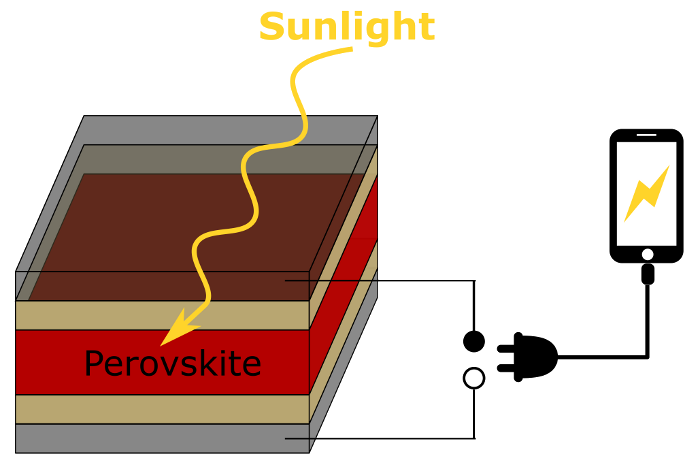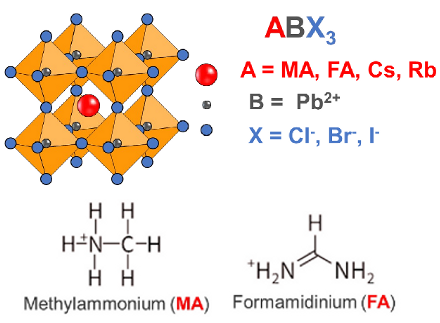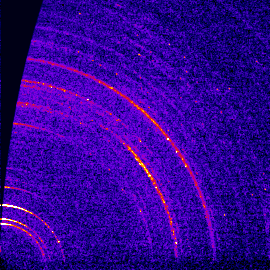 Perovskites have been known for a long time
as materials with many unique and fascinating properties, which
strongly depend on the material composition. Over the last decade,
hybrid perovskites have emerged as promising materials for building
solar cells, which might help to meet our growing energy demand by
harvesting solar energy. Within less than ten years of intensive
research, the efficiency of perovskite solar cells increased
dramatically from the first perovskite sensitized solar cells with
merely 3.8% conversion efficiency to now striking 25% for lab-scale
devices. This impressive efficiency boost within such a short time
might predict that perovskite solar cells will soon compete with
conventional solar cell materials. In comparison, silicon solar cells
have an efficiency of about 27% depending on the construction
type. Even higher efficiencies are achievable upon combining both
perovskite and silicon in tandem cells (29.1% so far). The greatest
advantages of perovskite materials against conventional solar cell
materials such as silicon lie in the fabrication process: hybrid
perovskite materials could be produced from abundant starting
materials using simple processes. As a result, production costs could
be significantly reduced and solar cells could be fabricated easily
and more economically. In addition, perovskite production needs
comparatively little energy input. As a result, the energy balance,
from the production of a perovskite solar cell through its use to its
end, has a higher output than conventional materials. Silicon solar
cells, for instance, are usually fabricated with very energy-intensive
processes. That is why it can take several years to regain the energy
spent for production of silicon solar cells while for perovskite cells
this can be achieved within a few months. In addition, perovskites
exhibit further remarkable properties that open up new possibilities:
they are suitable, for example, for curved, flexible or even
transparent substrate materials. This enables them to be used on bent
surfaces or in elastic components. The easy tunability of perovskite
materials is also a strong benefit, as will be described below.
Perovskites have been known for a long time
as materials with many unique and fascinating properties, which
strongly depend on the material composition. Over the last decade,
hybrid perovskites have emerged as promising materials for building
solar cells, which might help to meet our growing energy demand by
harvesting solar energy. Within less than ten years of intensive
research, the efficiency of perovskite solar cells increased
dramatically from the first perovskite sensitized solar cells with
merely 3.8% conversion efficiency to now striking 25% for lab-scale
devices. This impressive efficiency boost within such a short time
might predict that perovskite solar cells will soon compete with
conventional solar cell materials. In comparison, silicon solar cells
have an efficiency of about 27% depending on the construction
type. Even higher efficiencies are achievable upon combining both
perovskite and silicon in tandem cells (29.1% so far). The greatest
advantages of perovskite materials against conventional solar cell
materials such as silicon lie in the fabrication process: hybrid
perovskite materials could be produced from abundant starting
materials using simple processes. As a result, production costs could
be significantly reduced and solar cells could be fabricated easily
and more economically. In addition, perovskite production needs
comparatively little energy input. As a result, the energy balance,
from the production of a perovskite solar cell through its use to its
end, has a higher output than conventional materials. Silicon solar
cells, for instance, are usually fabricated with very energy-intensive
processes. That is why it can take several years to regain the energy
spent for production of silicon solar cells while for perovskite cells
this can be achieved within a few months. In addition, perovskites
exhibit further remarkable properties that open up new possibilities:
they are suitable, for example, for curved, flexible or even
transparent substrate materials. This enables them to be used on bent
surfaces or in elastic components. The easy tunability of perovskite
materials is also a strong benefit, as will be described below.
Figure 1: (right) Perovskite solar cell.
 The perovskite structure, which was derived
from the original mineral perovskite, can be formed by a variety of
materials. They all have an analogous structure composed of three
types of ions in order to obtain an ABX3 composition. Here,
A and B are two different types of cations, and X is an anion. In the
general perovskite structure, the ions always have the same
arrangement which is shown in Figure 2. In order to form the
structure, certain requirements for the size of the ions must be met
so that everything fits together well, as shown here. In addition, the
charge balance must also be guaranteed, so that the material is
electrically neutral. Ion size and charge neutrality are thus the two
most important criteria when selecting the ions for a perovskite
material. What we mean when we speak of "perovskite" is a variety of
materials (which are made by us) that form a perovskite
structure. There are quite a number of these, as in principle many
different ions can be mixed in order to obtain a material with a
perovskite structure, taking into account the conditions mentioned
above. We focus on a certain selection of materials, which we can,
however, constantly change and expand, especially with regard to the
cations. Generally speaking, we are investigating organic-inorganic
hybrid metal-halide perovskites. The most frequently used ions that
compose our perovskite materials are also listed in Figure 2. The
great diversity and variability in the composition of perovskites is
an important part of their appealc. It enables an enormous adaptability with simple
means, as it did not exist with conventional solar cell or
semiconductor materials so far.
The perovskite structure, which was derived
from the original mineral perovskite, can be formed by a variety of
materials. They all have an analogous structure composed of three
types of ions in order to obtain an ABX3 composition. Here,
A and B are two different types of cations, and X is an anion. In the
general perovskite structure, the ions always have the same
arrangement which is shown in Figure 2. In order to form the
structure, certain requirements for the size of the ions must be met
so that everything fits together well, as shown here. In addition, the
charge balance must also be guaranteed, so that the material is
electrically neutral. Ion size and charge neutrality are thus the two
most important criteria when selecting the ions for a perovskite
material. What we mean when we speak of "perovskite" is a variety of
materials (which are made by us) that form a perovskite
structure. There are quite a number of these, as in principle many
different ions can be mixed in order to obtain a material with a
perovskite structure, taking into account the conditions mentioned
above. We focus on a certain selection of materials, which we can,
however, constantly change and expand, especially with regard to the
cations. Generally speaking, we are investigating organic-inorganic
hybrid metal-halide perovskites. The most frequently used ions that
compose our perovskite materials are also listed in Figure 2. The
great diversity and variability in the composition of perovskites is
an important part of their appealc. It enables an enormous adaptability with simple
means, as it did not exist with conventional solar cell or
semiconductor materials so far.  By tuning the composition of the perovskite
films, not only the intrinsic material properties, but also the growth
and formation of the crystal structure and morphology can be
significantly improved. We are using grazing incidence wide angle
x-ray scattering (GIWAXS) to determine relevant structural properties
of perovskite thin films: precursor material conversion, intermediate
phase formation and perovskite unit cell parameter changes during thin
film crystallization. All this information can be extracted from the
GIWAXS images. In addition to ex-situ GIWAXS to characterize finished
films, we also perform in-situ measurements during film
production. For that purpose, we employ a self-built spin coating
chamber, which enables us to observe the film formation and
crystallization in real time. Since this is likely to produce a
massive amount of data, we also apply machine learning to accelerate
the data analysis.
By tuning the composition of the perovskite
films, not only the intrinsic material properties, but also the growth
and formation of the crystal structure and morphology can be
significantly improved. We are using grazing incidence wide angle
x-ray scattering (GIWAXS) to determine relevant structural properties
of perovskite thin films: precursor material conversion, intermediate
phase formation and perovskite unit cell parameter changes during thin
film crystallization. All this information can be extracted from the
GIWAXS images. In addition to ex-situ GIWAXS to characterize finished
films, we also perform in-situ measurements during film
production. For that purpose, we employ a self-built spin coating
chamber, which enables us to observe the film formation and
crystallization in real time. Since this is likely to produce a
massive amount of data, we also apply machine learning to accelerate
the data analysis.